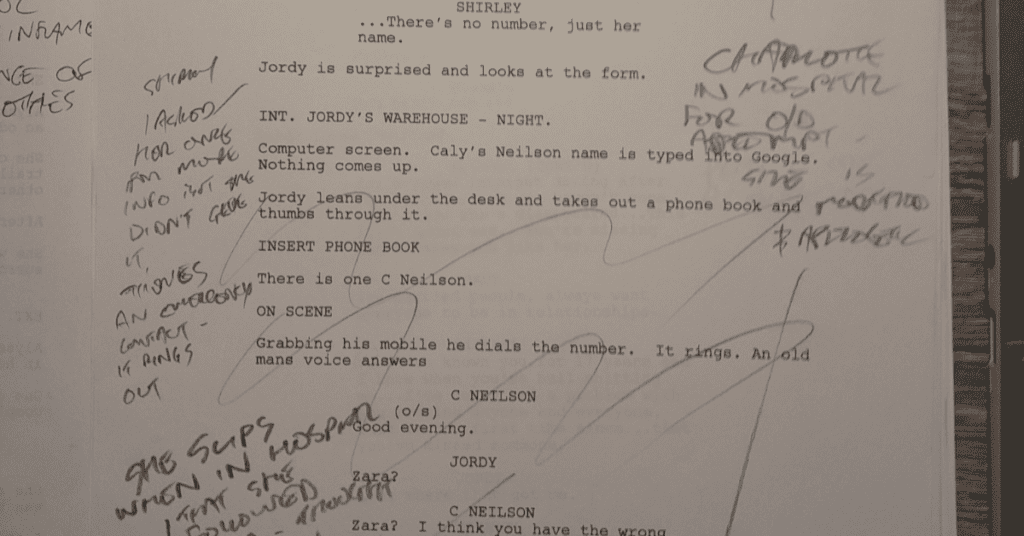One of the most important skills to master and an integral part of the writing process is rewriting.
The following tips are for rewriting early drafts, eg going from 1st to 2nd draft or 2nd draft to 3rd draft.
As your script nears production you are polishing rather than rewriting significant aspects which is a different process.
1. Your Early Draft Needs To Be Rewritten
The most important part to understand with rewriting is that your early drafts will require rewriting. Even the fabled ‘really great first draft’ requires rewriting.
Once you accept that you didn’t get everything right the first time around and that you can improve your screenplay you have taken a fundamental step towards being a better writer.
2. Have A Break From Your Screenplay.
There is nothing better than some time away from your screenplay. Having a break will allow your work to percolate in your mind without the pressure of writing. A break also gives you some time away from the story for your mind to rest.
How long a break between drafts is the obvious question and the answer is – it depends.
I have a 1 week break if I have a deadline or haven’t emptied out on the previous draft and up to a month or longer if I need some significant space from it. I also will have a longer break if I am writing another screenplay or directing a project.
3-6 months away from a screenplay whilst writing another one gives tremendous perspective, in both a good and bad way, on what you have written. Ultimately the time will differ writer to writer and project to project.
NB. Steps 3&4 I undertake for my own screenplays and for screenplays of writers in my mentoring programs or those who I’m completing a draft feedback report for.
3. Read The Draft Uninterrupted.
When you sit down to read your draft do it as one continuous sitting. Have a pen or pencil ( I prefer an old school grey lead pencil) in your hand and make some notes on the page (for me it will be an obvious typo, a formatting error or if something is jarring the rhythm of the read) but don’t stop reading to make extensive notes, there will be time for that.
You want to get the feel of how the flow and timing of the script and story plays out as if watching the film rather than a stop start reading process.
4. Write Your Initial Thoughts.
Write down your initial thoughts on what needs work. I scribble these on the front page of the script to refer back to later.
Here’s selected notes on the first draft of a screenplay I started this year.
The main weakness of this draft is the antagonists.
Inject the antagonists more into the story with increased screentime.
Make the antagonists more of a threat to increase the risk to the protagonist.
Hide the reveal of the 2nd antagonist until the second phone call on page 40.
Use the kangaroos decapitated head as a decoy (I’ll leave that cryptic note for you to guess what it’s about).
The search sequence needs a reorder of some scenes, it needs to feel like they have exhausted all options in their search of the cave.
Change the order of some of the searching scenes and make it harder physically for the protagonist whilst searching, add another obstacle.
Needs a chase sequence to end Act 2.
Develop Trevor’s arc of dependence on technology to abandoning it.
It’s also helpful to write down what you like about the draft and story to remind you of why you’re writing it and the strengths you can build on in the next draft.
5. Develop A Next draft Plan.
I don’t do this straight after writing the notes, I usually wait until the next day to see what I’m thinking after my initial read and notes, your first impressions may have changed or other things have occurred to you or if you’re lucky a solution as already presented itself.
Write down what you plan to do with the next draft based on your notes.
This could be things like
Do research on an aspect of your script, this could be a historical event that your story is based on, it could be a piece of technology your protagonist uses to achieve their goal, it could be true stories of similar scenarios you are writing about (these are great for sparking ideas).
Develop the protagonist’s back story.
Brainstorm a better 1st Act turn.
Which scenes to cut.
Which scenes to re-order.
New scenes to be written.
As part of the plan I also like to determine the date to complete the next draft . By now you all know how much I love setting deadlines for writing to both motivate and be productive (and create a sense of urgency to get cracking) so set a deadline to complete your next draft.
6. Create A New File For The Next Draft.
Whenever you start a new draft cut and paste the previous draft in a new document in your screenwriting program and work from that.
By doing this you will always have a permanent copy of all drafts and therefore can make wholesale changes and if they aren’t working you can return to you initial work. You also may need to revisit an older draft to gain perspective on new rewrites.
Finally, having all the drafts means that in the worst case scenario of a copyright dispute you can prove chain of title and your ownership of the work.
7. Rewrite Not Tweak Your Draft.
The biggest mistake writers make with rewrites is to make little tweaks or polish their script as a rewrite, tinkering with dialogue isn’t rewriting, it’s polishing.
Early drafts of the script will require some significant work including: cutting entire scenes, reordering scenes, adding scenes, removing a character, adding a character, in fact you may need to re-plot an entire Act.
Here is an example from a script I’m writing at the moment to show what I mean.

However, don’t butcher your entire screenplay and wreck the sections that are working. The rewrite is about building on the strengths of the previous draft and addressing the weaknesses.
8. Not everything can be fixed in the next draft.
You can’t fix everything or rewrite every scene of your screenplay for each draft so you need to prioritise what you want to fix.
There will be time and drafts to perfect all aspects of your screenplay so for the next rewrite work out what you think needs the most work, is the most pressing or what you are clear on how you’ll fix it.
Also have a few ‘that will be really easy to fix’ in your plan, writing can be difficult as we know so having some easy scenes to focus on helps build momentum.
Some examples of this are
I was writing a thriller that had a death scene I wasn’t happy with how it was playing out, it wasn’t terrible, it was serviceable but could have been ‘a cooler death’. I decided to wait until the next draft to invest time and energy into improving that scene. I focused on the sequence of events that lead up to that death as I felt it wasn’t clear enough in the story build and therefore more pressing.
An easy fix was upon reading the draft it was clear a montage was required, I always find them easy to write so I started there to get the process going.
9. Print And Set Aside.
The final stage of your rewrite is to print out the completed draft. I love that moment of the final page of a script coming out of the printer, it’s a visual representation of a goal you’ve achieved. Once you’ve printed it out sit it on your desk where it will wait until you choose to return and start the process again.





